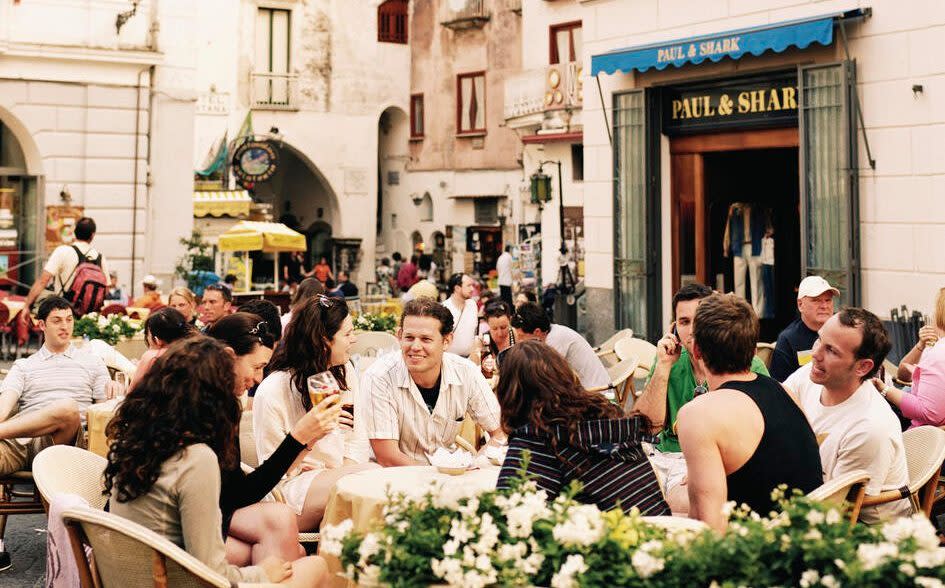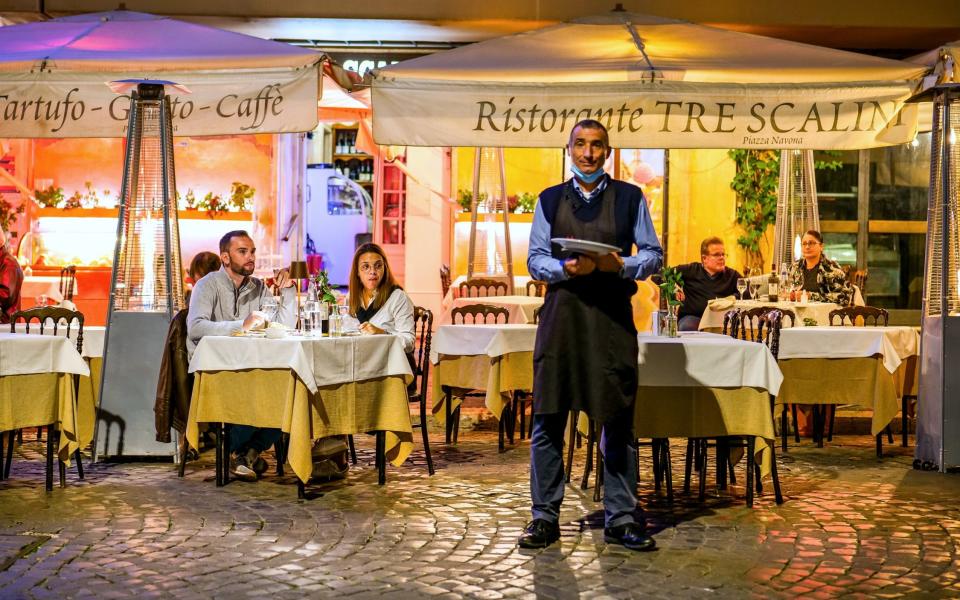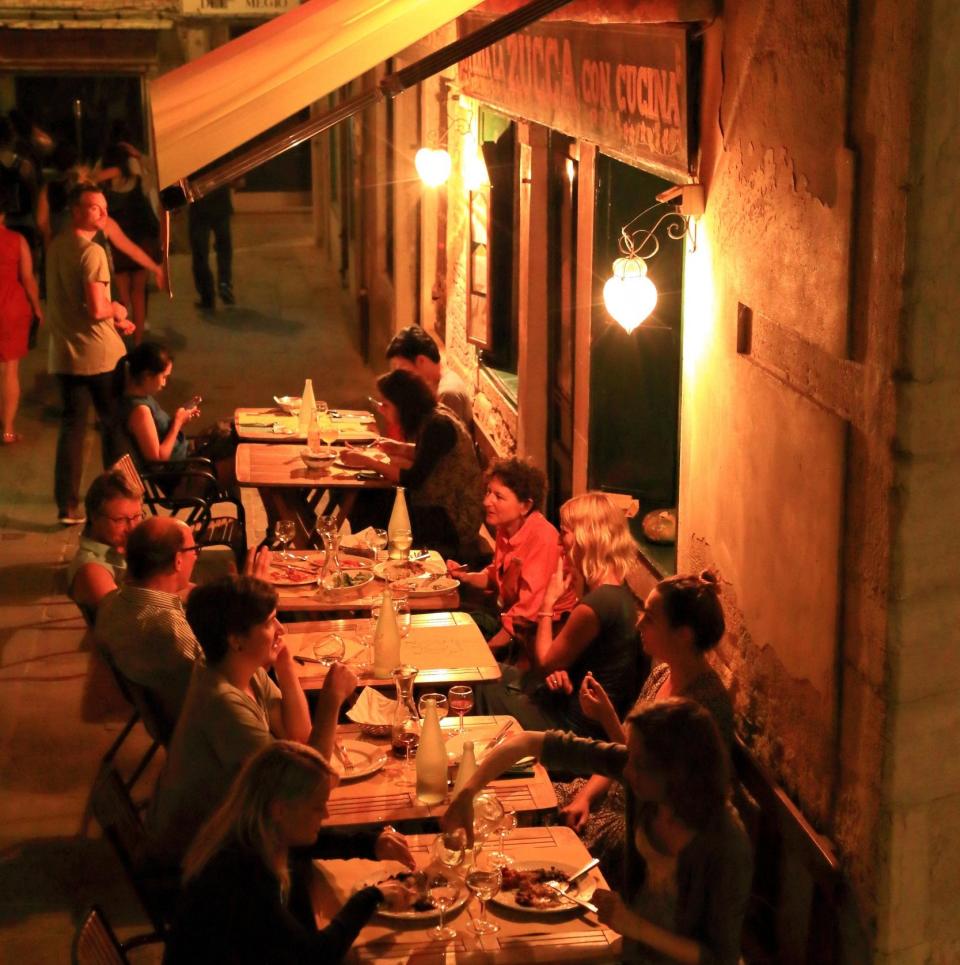How to effortlessly eat well and avoid the tourist traps on holiday

After a long day hobbling over the cobblestones of ancient Rome, fuelled by gelato and Campari, I succumbed to an overzealous Italian.
The restaurant greeter in a skimpy vest and ripped jeans was drenched in sweat, chain smoking and gesticulating like Basil Fawlty.
We would under normal circumstances have given him a wide berth, but we were exhausted – so we sat down at a plastic table surrounded by British and American couples.
After a carafe of warm white wine, some overcooked linguine alla gritty vongole and the most revolting lasagne I have had since ordering one on a Ryanair flight, a bill for €85 (£70) arrived. I could have cried.
The food was diabolical, but I blamed myself. We all make these mistakes when eating out on holiday, but I pride myself on knowing all the signs: what to look for and what to avoid. I let the side down.
To prevent you from making the same mistakes this summer, here is what to look out for when eating out abroad. And – more importantly – what to avoid.
1. Look out for pushy greeters
There is one key, unmissable signifier of a tourist-trap restaurant: the pushy host desperately battling to drag you through the doors. Not all tourist-trap restaurants have pushy hosts, but all restaurants with pushy hosts are tourist traps. They have heard all of your lies before – “Maybe later”, “No thanks, I’ve already eaten”, “It’s my first day, maybe tomorrow” – so they are happy to persevere. Let’s face it, though, if a restaurant is any good it won’t need to waste money on a street salesperson.

2. Beware of menus displayed outside
In all fairness, most restaurants display menus outside – even some of the best in the world. After all, people like to know what they are about to eat, and how much they are likely to pay. But if a restaurant displays menus printed in various different languages, it is likely their key intent is to rip off tourists – so you should avoid it like the plague. If a restaurant has a single, multilingual menu outside, it should be printed only in the restaurant’s native tongue and in the second most popular language locally, which will differ by country. Also avoid a place where the menus are generic, laminated and look as though they haven’t been changed since the fall of Troy.
3. Ignore TripAdvisor stickers
While websites such as TripAdvisor can be helpful, it is worth keeping in mind that restaurants proudly displaying stickers or posters about their positive reviews will most likely cater to tourists. Some are fine, but most will target unknowing holidaymakers rather than locals, shunning their own food culture and serving lacklustre versions of popular local dishes, plus burgers and chips for the less adventurous.
4. Study the crowd, especially at specific times
Observing crowds is a good way to suss out any restaurant. It is occasionally hard to tell, but if a place is full of locals it is usually a good sign. If a restaurant is full of people wearing bum bags and toting DSLR cameras as necklaces, it is perhaps best to walk on by. Note that meal times differ internationally. In many European countries, for instance, dinner is eaten later than in Britain and the United States. Therefore, if a European restaurant has a huge dinner rush at 6pm, it is most likely a tourist trap – or a retirement home.
5. Look for tell-tale signs of authenticity
Other than the menus, these differ by country. In Greece, for instance, an authentic, traditional taverna will have paper tablecloths and only very rarely a printed menu. The best Spanish tapas bars tend to have napkins and cocktail sticks strewn on the floor. Typical French bistros almost always have zinc bars and menus handwritten on chalkboards.

6. Avoid package tours if you are a serious foodie
For many holidaymakers, package tours are appealing. But if you are really looking to get under the skin of a country, they are less than ideal. Tour guides will often ferry you into restaurants that have paid for the guaranteed custom or will at least offer tour operators a hefty commission. Don’t expect fine food.
7. Stray from the beaten track, but not too far
When looking for an area’s best restaurants, most people will tell you to venture out of the city centres – but that’s not always the case. Contrary to popular belief, it is easy to eat extremely well within a stone’s throw of iconic landmarks – but you may need to divert from the beaten track a little.
Even in London, excellent restaurants in Chinatown, Soho and Covent Garden operate alongside the atrocities of Leicester Square. In Paris, Bouillon Pigalle offers French classics at eminently affordable prices in the shadow of Sacré-Cœur and Moulin Rouge, while L’Antica Pizzeria Da Michele in Naples is just a short walk from the cathedral.
8. Speak to locals, but forget the hotel concierge
Asking for recommendations is, most certainly, the easiest way to find a good restaurant. Hotel reception staff are a common go-to but should be avoided at all costs. Sure, it is a convenient option to ask the concierge, but recommendations are often disappointing and cater mainly to tourists.
Striking up conversations with strangers can be daunting (especially in an unfamiliar language), but locals are the best people to ask, be they shopkeepers, bartenders, cleaners, or taxi drivers. Briefly explain that you are looking for somewhere authentic, specify a rough budget and any key dishes you are keen to try. Ask them where they would eat with their family, and trust their judgement far more than the hotel staff.
9. Research at least one local dish
Research is a huge part of choosing where to go on holiday, but where to eat out is typically overlooked. Looking up local dishes online will help you to eat well. Each region has its own specialities, many of which don’t appear on menus at generic tourist restaurants.
Think bigoli in salsa in Venice, caldo verde in Portugal or paella in Valencia. Even if you have no intention of eating the dish you have researched, bringing it up in conversation with locals will show you are serious about finding somewhere authentic rather than somewhere frequented by tourists.

10. Leave snobbery at home
It goes without saying that many countries have different food, drink and hospitality customs to those we are used to. It is worth keeping that in mind when searching for a great eating experience. In some countries you may be required to remove your shoes, eat with just one hand, loudly slurp noodles, or face strict rules about what can and cannot be ordered together.
Sure, you will find plenty of hotel restaurants where you feel more relaxed, but for a truly authentic dining experience while travelling, it is worth keeping an open mind and stepping out of your comfort zone.
For full details of entry requirements and Covid rules for your favourite destinations, see telegraph.co.uk/tt-travelrules. Refer to gov.uk/foreign-travel-advice for further travel information.
Five authentic restaurants in Europe’s most touristy cities
Bar Pinotxo, Barcelona
The most popular of the counter bars at the city’s Boqueria market, Pinotxo has been going for more than 70 years and attracts top local chefs, including Ferran Adrià of El Bulli fame. Expect to queue for a coveted stool at the bar, where Juanito Bayén, the charismatic owner in his trademark bow tie, holds court. There is no menu, but you can inspect the platters displayed along the counter and ask for the daily specials. Try house classics such as txipirons amb mongetes (baby squid and beans) and truita de carxofes (artichoke omelette). pinotxobar.com

Da Gino al Parlamento, Rome
A rock amid the shifting sands of the Roman dining scene, the venerable trattoria of Luigi del Grosso, aka Gino, opened in 1963 in this alley by the parliament building and little has changed since then. It has the same kitsch murals, the same reliable versions of Roman classics such as tonnarelli cacio e pepe (pasta strands with tangy, melting sheep’s cheese and black pepper), involtini alla romana (veal rolls wrapped up with sage) and, of course, trippa (tripe). The clientele is more upmarket than the rustic ambience would suggest, with plenty of politicians and lobbyists at lunchtime. ristoranteparlamento.roma.it
La Zucca, Venice
This trattoria is a Venetian veteran, but time has eroded none of its charm, value for money or bravura (brilliance). The oak panelling inside comes on a little like an Alpine chalet, but the bottle-lined shelves and paper placemats are pure Venetian bacaro. The menu features as much meat as fish; you might start with tagliatelle with artichokes and pecorino cheese and follow with, say, duck baked with apples. There are also several vegetarian options. Service is friendly and attentive, and the wine list is well chosen and well priced. The few outside tables should be booked well in advance. lazucca.it

Au Pere Louis, Paris
Duck behind the large boulevards enclosing the Luxembourg Gardens to find Au Pere Louis, a wine bar and restaurant offering a convivial and tasty helping of traditional French hospitality. In the cosy space full of nooks and crannies, you will find more than 60 varieties of wine available by the glass and a very good-quality selection of regional brasserie classics such as French onion soup, Auvergne sausage or Toulouse cassoulet. A great selection of desserts, too. auperelouisrestaurant.fr
Cervejaria Ramiro, Lisbon
This much-loved restaurant is famous for its fresh seafood and has been going strong for more than 70 years, as its tiled interiors bear witness, offering an authentic glimpse of a Lisbon of yesteryear. The Mouraria neighbourhood is named after the Moors who were allowed to live here after the Christian reconquest of Lisbon in 1147. Step through the doors and you will see giant aquariums filled with spider crabs, rock lobsters and tiger prawns. Start with the house pata negra (smoked ham) or a plate of garlicky clams or goose barnacles, and finish with the delicious azeitão cheese. cervejariaramiro.com

